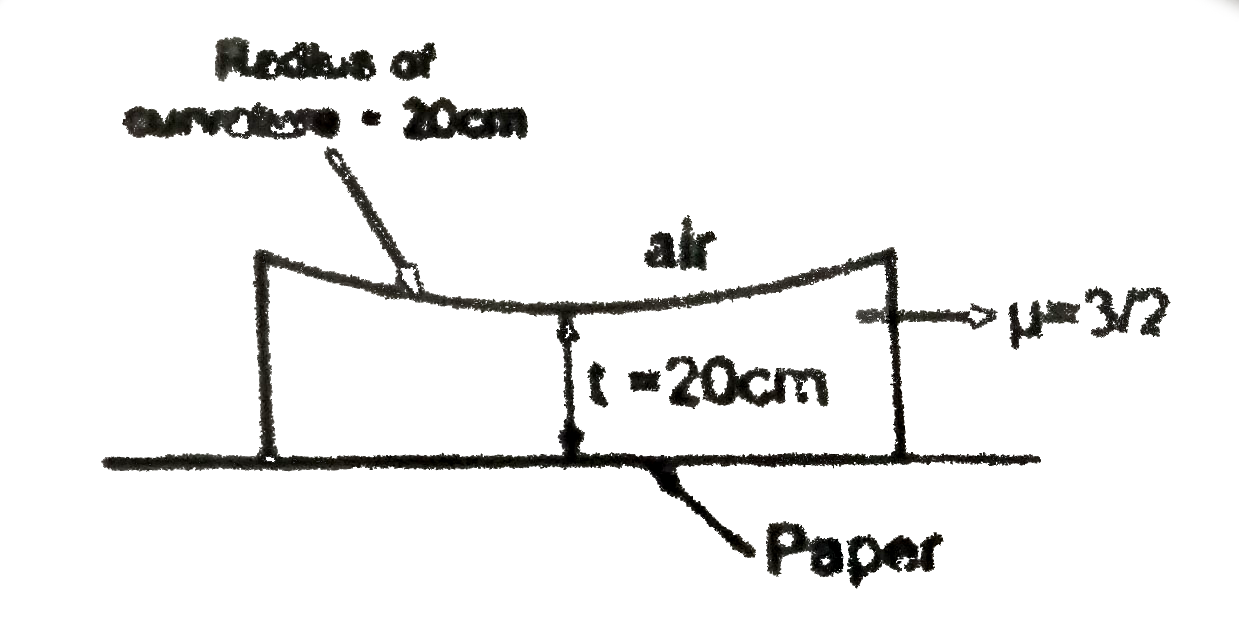Find the behaviour of concave lens placed in a rarrer medium.
To find the behavior of a concave lens placed in a rarer medium, we can follow these steps:
Step 1: Understand the Lens Maker's Formula
The lens maker's formula is given by:
1f=(μlμm−1)(1R1−1R2)
Where:
- f = focal length of the lens
- μl = refractive index of the lens
- μm = refractive index of the medium
- R1 and R2 = radii of curvature of the lens surfaces
Step 2: Identify the Conditions
In this case, we are dealing with a concave lens placed in a rarer medium. This means:
- The refractive index of the lens (μl) is greater than the refractive index of the medium (μm).
- Therefore, μlμm>1.
Step 3: Analyze the Terms
Since μlμm>1, the term (μlμm−1) is positive.
Now, we need to analyze the term (1R1−1R2):
- For a concave lens, R1 (the radius of curvature for the first surface) is negative (since it is measured opposite to the direction of the incident ray).
- R2 (the radius of curvature for the second surface) is positive (since it is measured in the direction of the incident ray).
Step 4: Substitute the Signs
Using the sign convention:
- Let R1=−|R1| (negative)
- Let R2=+|R2| (positive)
Thus, we have:
1R1−1R2=−1|R1|−1|R2|=−(1|R1|+1|R2|)
This term is negative.
Step 5: Determine the Focal Length
Now, we can analyze the overall expression for 1f:
1f=(positive)×(negative)=negative
Since 1f is negative, it implies that the focal length f is also negative.
Step 6: Conclusion
A negative focal length indicates that the lens is diverging. Therefore, we conclude that a concave lens placed in a rarer medium behaves as a diverging lens.
Summary
- A concave lens in a rarer medium has a negative focal length.
- It acts as a diverging lens.
The lens maker's formula is given by:
- f = focal length of the lens
- μl = refractive index of the lens
- μm = refractive index of the medium
- R1 and R2 = radii of curvature of the lens surfaces
In this case, we are dealing with a concave lens placed in a rarer medium. This means:
- The refractive index of the lens (μl) is greater than the refractive index of the medium (μm).
- Therefore, μlμm>1.
Since μlμm>1, the term (μlμm−1) is positive.
- For a concave lens, R1 (the radius of curvature for the first surface) is negative (since it is measured opposite to the direction of the incident ray).
- R2 (the radius of curvature for the second surface) is positive (since it is measured in the direction of the incident ray).
Using the sign convention:
- Let R1=−|R1| (negative)
- Let R2=+|R2| (positive)
Now, we can analyze the overall expression for 1f:
A negative focal length indicates that the lens is diverging. Therefore, we conclude that a concave lens placed in a rarer medium behaves as a diverging lens.
- A concave lens in a rarer medium has a negative focal length.
- It acts as a diverging lens.
Topper's Solved these Questions
- BOOK - RESONANCE ENGLISHCHAPTER - GEOMATRICAL OPTICS EXERCISE - Problem33videos
GEOMATRICAL OPTICS
- BOOK - RESONANCE ENGLISHCHAPTER - GEOMATRICAL OPTICS EXERCISE - Exercise-1141videos
GEOMATRICAL OPTICS
- BOOK - RESONANCE ENGLISHCHAPTER - EXPERIMENTAL PHYSICSEXERCISE - PART -II10videos
EXPERIMENTAL PHYSICS
- BOOK - RESONANCE ENGLISHCHAPTER - GRAVITATIONEXERCISE - HIGH LEVEL PROBLEMS16videos
GRAVITATION
Similar Questions
In the given figure a plano-concave lens is placed on a paper on which a flower is drawn. How far above its actual position does the flower appear to be ?
 View Solution
View SolutionFind the power of a concave lens of focal length 2m.
View SolutionConcave lens is employed to correct
View SolutionSTATEMENT - 1 : When a lens is placed in a medium for which μ is less than of the lens, its focal length is moer than focal length in air.
STATEMENT - 2 : When the lens is placed in a medium for which μ is greater than that of the lens. The nature of the lens remains unchanged.
STATEMENT - 3 : When a lens of focal length f is placed in a medium for which μ is same as that of the lens then the power of the lens becomes zeroView SolutionA point object is placed at a distance of 15 cm from a convex lens. The image is formed on the other side at a distance of 30 cm from the lens. When a concave lens is placed in contact with the convex lens, the image shifts away further by 30 cm. Calculate the focal lengths of the two lenses.
View SolutionUnder what condition, a concave lens can make a real image.
View SolutionRefractive index of the material of concave lens is μ. The lens is immersed inb a medium of refractive index μ1(μ1>μ). A parallel beam of light is incident on the lens. Draw a diagram to show the path of emergent rays.
View SolutionDraw ray diagrams showing the image formation by a concave lens when an object is placed
(a) between focus and twice the focal length of the lens
(b) beyond twice the focal length of the lensView SolutionThe radii of curvature of a lens are + 20 cm and + 30 cm. The material of the lens has a refracting index 1-6. Find the focal length of the lens (a) if it is placed in air, and (b) if it is placed in water (mu = 1.33).
View SolutionAn equiconcave lens has power P. Find power of plano concave lens when given lens is cut in such a way that two plano concave lens are formed.
View Solution

